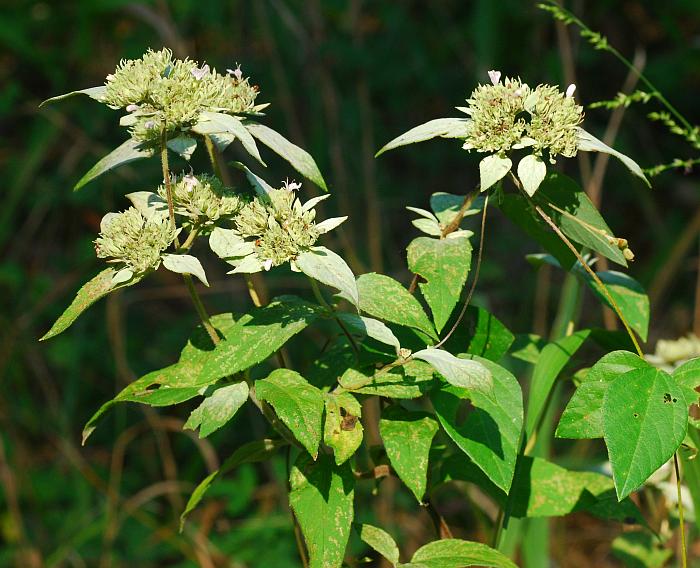Pycnanthemum albescens Torr. & A. Gray
White Mountain Mint

Native
CC = 7
CW = 3
MOC = 27
© SRTurner
Pycnanthemum albescens Torr. & A. GrayWhite Mountain Mint | |
 |
Native CC = 7 CW = 3 MOC = 27 |
© SRTurner |
|
Family - Lamiaceae Habit - Rhizomatous perennial forb. Stems - Ascending to erect, to 90 cm, multiple from the base, branching, 4-angled, fragrant, hollow, pubescent on the angles and sides with a mixture of moderate to dense, short, curled hairs and sparser, longer, spreading hairs.
Leaves - Opposite, simple, decussate, sessile to short-petiolate. Largest leaves with the petioles 4-12 mm long. Leaf blades 2.5-7.0 cm long, 15-25 mm wide, ovate to broadly lanceolate or narrowly elliptic, angled or tapered at the base, the margins often finely toothed; the upper surface of the lower and median leaves sparsely to densely short-hairy and usually somewhat grayish, that of the uppermost leaves usually whitened with dense, short, curled hairs; the undersurface of all of the leaves pale or whitened with dense, short curled hairs and occasionally with a few longer, spreading hairs along the veins.
Inflorescence - Relatively open clusters at stem and branch tips, often appearing broadly rounded, the branches mostly observable, at least at fruiting. Bracts leaflike, whitened with dense, short, curled hairs on usually both surfaces. Bractlets 2-4 mm long, linear to narrowly lanceolate.
Flowers - Calyces 3.5-5.0 mm long, zygomorphic, 2-lipped, densely pubescent with minute, appressed hairs, lacking longer bristly hairs on the margins or tip, the upper lip shallowly 3-lobed, the lobes 0.4-0.6 mm long, triangular, bluntly pointed, the lower lip more deeply 2-lobed, the lobes 1.0-1.5 mm long, ovate to oblongovate, bluntly pointed. Corollas zygomorphic, bilabiate, 5-8 mm long, white to pale lavender. Corolla tube glabrous externally, pubescent internally. Lobes glandular and pubescent externally. Lower lip single-lobed, the lobe 4 mm long, 1.5mm broad, white. Upper lip 3-lobed, 4-5 mm broad, the lobes deflexed, spotted with purple internally. Central lobe bent forward at the apex. Lateral lobes shorter than the central. Stamens 4, subequal, exserted, adnate at the apex of the corolla tube, alternating with the corolla lobes. Filaments 4-5 mm long, white, glabrous. Anthers 0.8 mm long, orange. Style white, glabrous, exserted, 7-8 mm long. Stigma unequally 2-lobed. Ovary 4-lobed, green.
Fruits - Nutlets 1.0-1.4 mm long, hairy toward the tip.
Flowering - July - September. Habitat - Mesic to dry upland forests, savannas, sand prairies, ledges of bluffs, acid seeps, pastures, fields. Origin - Native to the U.S. Lookalikes - P. muticum. Other info. - This species can be found in the southern third of Missouri. Beyond Missouri its range is a tightly defined region extending southward to the Gulf Coast, and ranging from eastern Texas to the Florida panhandle. The plant is identified by its minty fragrance and whitish upper bracts; however, these characters also describe the lookalike P. muticum. The two can be distinguished by the shape of the leaves, which in P. albescens are tapered at the base, and in P. muticum are rounded at the base. In addition, P. muticum has tighter inflorescences. These two species have been claimed to hybridize when grown in proximity. Photographs taken at the Peck Ranch Wildlife Refuge, Carter County, MO., 7-19-01, and near Stegal Mountain, Shannon County, MO., 8-10-03 (DETenaglia); also at Hawn State Park, Ste. Genevieve County, MO, 9-1-2008 and 7-24-2017, and at Holly Ridge Conservation Area, Stoddard County, MO, 8-07-2022 (SRTurner). Seeds for imaging supplied by KBildner, Nov. 2024. |